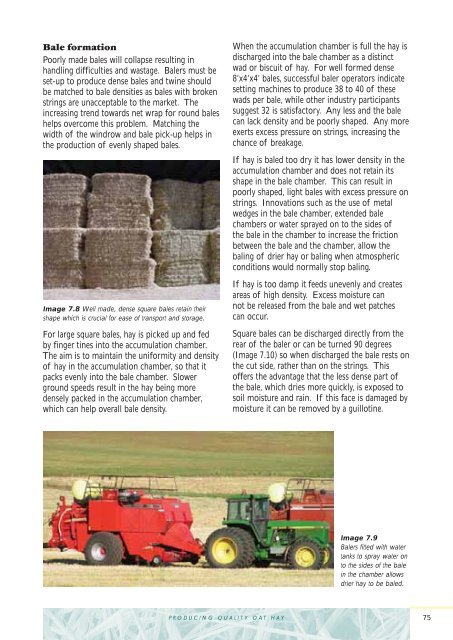You also want an ePaper? Increase the reach of your titles
YUMPU automatically turns print PDFs into web optimized ePapers that Google loves.
Bale formation<br />
Poorly made bales will collapse resulting in<br />
handling difficulties and wastage. Balers must be<br />
set-up to produce dense bales and twine should<br />
be matched to bale densities as bales with broken<br />
strings are unacceptable to the market. The<br />
increasing trend towards net wrap for round bales<br />
helps overcome this problem. Matching the<br />
width of the windrow and bale pick-up helps in<br />
the production of evenly shaped bales.<br />
Image 7.8 Well made, dense square bales retain their<br />
shape which is crucial for ease of transport and storage.<br />
For large square bales, hay is picked up and fed<br />
by finger tines into the accumulation chamber.<br />
The aim is to maintain the uniformity and density<br />
of hay in the accumulation chamber, so that it<br />
packs evenly into the bale chamber. Slower<br />
ground speeds result in the hay being more<br />
densely packed in the accumulation chamber,<br />
which can help overall bale density.<br />
PRODUCING QUALITY OAT HAY<br />
When the accumulation chamber is full the hay is<br />
discharged into the bale chamber as a distinct<br />
wad or biscuit of hay. For well formed dense<br />
8’x4’x4’ bales, successful baler operators indicate<br />
setting machines to produce 38 to 40 of these<br />
wads per bale, while other industry participants<br />
suggest 32 is satisfactory. Any less and the bale<br />
can lack density and be poorly shaped. Any more<br />
exerts excess pressure on strings, increasing the<br />
chance of breakage.<br />
If hay is baled too dry it has lower density in the<br />
accumulation chamber and does not retain its<br />
shape in the bale chamber. This can result in<br />
poorly shaped, light bales with excess pressure on<br />
strings. Innovations such as the use of metal<br />
wedges in the bale chamber, extended bale<br />
chambers or water sprayed on to the sides of<br />
the bale in the chamber to increase the friction<br />
between the bale and the chamber, allow the<br />
baling of drier hay or baling when atmospheric<br />
conditions would normally stop baling.<br />
If hay is too damp it feeds unevenly and creates<br />
areas of high density. Excess moisture can<br />
not be released from the bale and wet patches<br />
can occur.<br />
Square bales can be discharged directly from the<br />
rear of the baler or can be turned 90 degrees<br />
(Image 7.10) so when discharged the bale rests on<br />
the cut side, rather than on the strings. This<br />
offers the advantage that the less dense part of<br />
the bale, which dries more quickly, is exposed to<br />
soil moisture and rain. If this face is damaged by<br />
moisture it can be removed by a guillotine.<br />
Image 7.9<br />
Balers fitted with water<br />
tanks to spray water on<br />
to the sides of the bale<br />
in the chamber allows<br />
drier hay to be baled.<br />
75

















